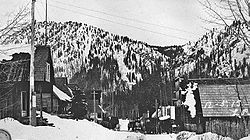According to several historians, the U.S. state of Oregon contains over 200 ghost towns. [1] [2] Professor and historian Stephen Arndt has counted a total of 256 ghost towns in the state, some well known, others "really obscure." [3] The high number of ghost towns and former communities in the state is largely due to its frontier history and the influx of pioneers who emerged in the area during the 19th century. [2] Many of the ghost towns in Oregon were once mining or lumber camps that were abandoned after their respective industries became unprosperous. [2]
Contents
This list includes towns and communities that have been described as ghost towns, and may be abandoned, unpopulated, or have populations that have declined to significantly small numbers; [a] some may still be classified as unincorporated communities. As of 2019 [update] , some of the towns included may have small residual populations; others may retain few physical remnants of their existence, but are broadly considered ghost towns under prevailing definitions in the United States. [b]












